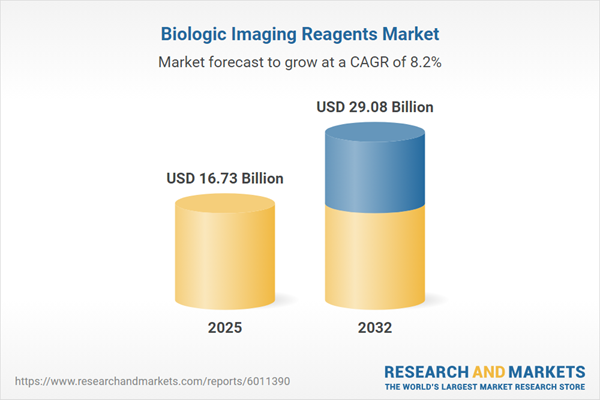Speak directly to the analyst to clarify any post sales queries you may have.
The Biologic Imaging Reagents Market is advancing rapidly, underpinned by continued innovation in molecular visualization and increasing demand for sensitive, real-time diagnostic solutions. Senior leaders require clear, actionable insights as this sector evolves to address both operational disruption and new scientific frontiers.
Market Snapshot: Biologic Imaging Reagents Market Growth
The Biologic Imaging Reagents Market grew from USD 15.48 billion in 2024 to USD 16.73 billion in 2025, with expectations for continued expansion at a CAGR of 8.19% and an anticipated value of USD 29.08 billion by 2032. This robust growth reflects rising utilization of advanced molecular imaging in disease diagnostics, preclinical research, and therapeutic monitoring across multiple sectors, including healthcare, biotechnology, and academia. Stakeholders are investing in innovative reagents to meet the demand for higher imaging precision and reliability in both research and clinical environments.
Scope & Segmentation
This report provides detailed segmentation and regional breakdowns, empowering industry decision-makers to identify high-opportunity markets and tailor strategies for volume, application, and specialization:
- Product Types: Contrast agents, fluorescent labels, luminescent probes, and quantum dots support diverse imaging requirements and platforms.
- Contrast Agents: Microbubbles, paramagnetic agents, and superparamagnetic iron oxide for enhanced tissue and vascular contrast.
- Fluorescent Labels: Fluorescent proteins, nanoparticles, and organic dyes for targeted, high-resolution visualization.
- Luminescent Probes: Bioluminescent and chemiluminescent reagents optimized for sensitive detection without external light activation.
- Quantum Dots: Carbon-based and cadmium selenide (CdSe) core formulations offering multiplexing capability and signal intensity.
- Imaging Modalities: Includes computed tomography (iodinated agents, nanoparticle agents), magnetic resonance imaging (T1 and T2 agents), optical imaging (bioluminescence, fluorescence), positron emission tomography (Fdg tracers), and single photon emission computed tomography (iodine and technetium agents).
- End Users: Academic and research institutes, contract research organizations, hospitals and diagnostic centers, pharmaceutical and biotechnology companies.
- Applications: Ex vivo imaging (tissue section, whole organ), in vitro imaging (microscopy, plate reader assays), and in vivo imaging (diagnostic imaging, therapeutic monitoring).
- Regions Covered: Americas (North America, Latin America), Europe, Middle East & Africa, Asia-Pacific—encompassing key geographies such as the United States, Canada, Germany, China, India, and others.
Key Takeaways for Decision-Makers
- Next-generation imaging reagents, leveraging quantum dots, superparamagnetic nanoparticles, and luminescent probes, are extending the boundaries of molecular precision and detection sensitivity in both research and clinical settings.
- Integration of machine learning with reagent design is accelerating innovation, aiding in target specificity and facilitating rapid iteration for new applications.
- Operational agility is enhanced through modular manufacturing platforms, supporting efficient scale-up and quality assurance for complex biologic products.
- Collaborative development between industry and academia is central for validating novel reagents and ensuring compatibility with emerging imaging platforms.
- Sustainable production protocols and adherence to evolving regulatory standards are supporting market credibility and fostering trust in clinical environments.
Tariff Impact: Navigating 2025 US Policy Adjustments
Recent adjustments to United States import tariffs have impacted biologic imaging reagent suppliers and global supply chains. Cost increases on key raw materials, such as iodinated and nanoparticle agents, prompted procurement shifts and manufacturing strategy reevaluation. Many organizations have responded by renegotiating supplier contracts, exploring local production, and implementing just-in-time inventory models to maintain resilience. While these disruptions have increased operational complexity, they have also accelerated diversification of supply sources and broader regional manufacturing investment. End users, from research institutions to hospitals, are adapting budgets and procurement strategies to balance throughput and cost control amidst an uncertain regulatory landscape.
Primary Keyword: Biologic Imaging Reagents Market
Methodology & Data Sources
Findings in this report are derived from extensive secondary research and in-depth primary interviews with decision-makers, researchers, and regulatory experts. Data sources include published peer-reviewed journals, industry reports, company documentation, and firsthand qualitative interviews, ensuring a comprehensive perspective tailored to senior leadership needs.
Why This Report Matters
- Offers actionable intelligence and benchmarking for product development, procurement, and investment prioritization within the imaging reagents sector.
- Delivers a clear understanding of complex market segmentation, regional dynamics, and disruptive trends, supporting informed, real-time strategic decision-making.
- Enables leadership teams to navigate policy shifts, supply chain risks, and innovation opportunities with confidence and agility.
Conclusion
Senior decision-makers gain a holistic view of biologic imaging reagent market development, technology integration, and operational strategy. This report empowers leaders to manage emerging risks and capitalize on evolving growth opportunities.
Additional Product Information:
- Purchase of this report includes 1 year online access with quarterly updates.
- This report can be updated on request. Please contact our Customer Experience team using the Ask a Question widget on our website.
Table of Contents
3. Executive Summary
4. Market Overview
7. Cumulative Impact of Artificial Intelligence 2025
Companies Mentioned
The companies profiled in this Biologic Imaging Reagents market report include:- Thermo Fisher Scientific Inc.
- Merck KGaA
- Danaher Corporation
- PerkinElmer, Inc.
- Bio-Rad Laboratories, Inc.
- Agilent Technologies, Inc.
- Abcam plc
- QIAGEN N.V.
- Becton, Dickinson and Company
- Luminex Corporation
Table Information
| Report Attribute | Details |
|---|---|
| No. of Pages | 187 |
| Published | October 2025 |
| Forecast Period | 2025 - 2032 |
| Estimated Market Value ( USD | $ 16.73 Billion |
| Forecasted Market Value ( USD | $ 29.08 Billion |
| Compound Annual Growth Rate | 8.1% |
| Regions Covered | Global |
| No. of Companies Mentioned | 11 |









